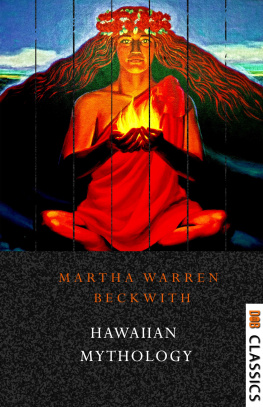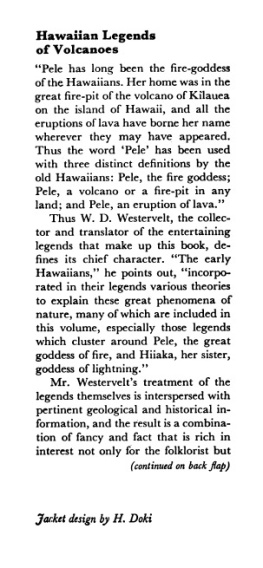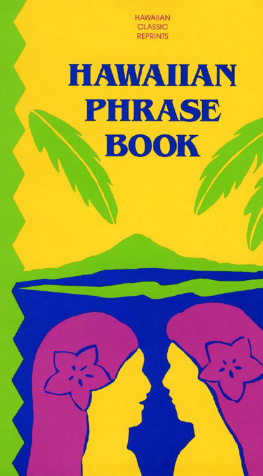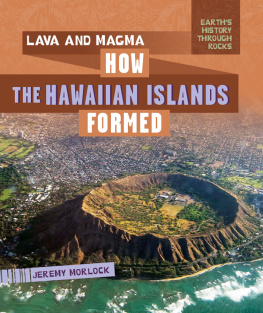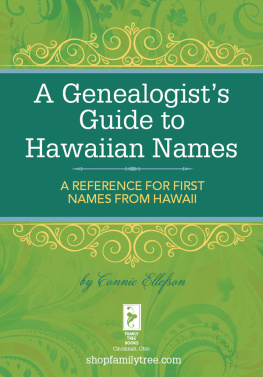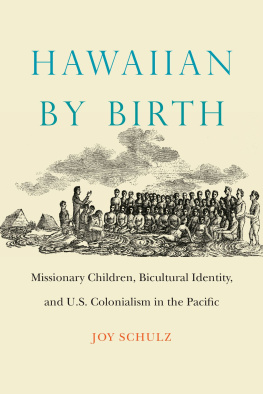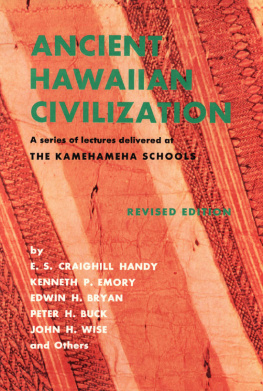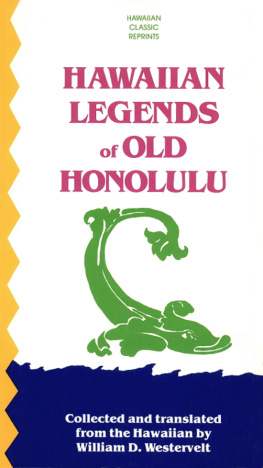HAWAIIAN
MYTHOLOGY
BY
MARTHA WARREN BECKWITH
1940
Contents
Preface
THIS guide to the native mythology of Hawaii has grown out of a childhood and youth spent within sound of the hula drum at the foot of the domelike House of the Sun on the windy island of Maui. There, wandering along its rocky coast and sandy beaches, exploring its windward gorges, riding above the cliffs by moonlight when the surf was high or into the deep forests at midday, we were aware always of a life just out of reach of us latecomers but lived intensely by the kindly, generous race who had chanced so many centuries ago upon its shores.
Not before 1914 did the actual shaping of the work begin. The study covers, as any old Hawaiian will discover, less than half the story, but it may serve to start specific answers to the problems here raised and to distinguish the molding forces which have entered into the recasting of such traditional story-telling as has survived the first hundred years of foreign contact.
To the general student of mythology the number and length of proper names in an unfamiliar tongue may seem confusing. Hawaiian proper names are rarely made up of a single word but rather form a series of words recalling some incident or referring to some characteristic significant of the person or place designated.
To a personal name an epithet may be affixed, such as "o ka lani" which means literally "of the heavens" but is translated by Hawaiians by the term "heavenly" as a title of endearment or adoration.
The name of the parent is often added with the causal possessive "a" meaning "child of," as in Umi-a-Liloa, which may be read "Umi, child of Liloa." In many cases the definite article "ka" becomes a part of the name and hence the preponderance in Hawaiian of names beginning with this syllable.
Since recognition of its composition is essential to its proper accent, in cases where this is known with a good degree of probability through native informants, the name has been hyphenated upon its first appearance and occasionally throughout.
With the analysis of the name in mind, the pronunciation offers little difficulty. There are no silent letters. Theoretically at least, each vowel represents a distinct sound; each consonant is voiced as a distinct syllable ending in a vowel sound. Words written alike but different in meaning are to be distinguished, however, only by their spoken accent, as Ka-u', The-breast, which names a district on Hawaii, and kau for the summer season. A third form, kau, for the possessive pronoun of the first person singular, pronounced with a glottal stop, is written with the inverted apostrophe called a hamzah, indicative of a lost consonant sound in the k range.
Besides the five vowel sounds, pronounced as in Italian, only seven consonants were recognized in the reduction of the language to writing by the early American missionaries and these do not differ from the same signs in English; the shifting of l to r, k to t, p to f, and w to v characteristic of various Polynesian dialects and recognized in the oral speech of old Hawaiians is hence ignored in the written form.
The effect upon Hawaiian speech of this melodious heaping up of sound without articulation is altogether pleasing and lends itself easily to the chanting of long poetical recitations such as Hawaiians of the old days delighted in, as in the shorter and more varied poetry of dance and celebration.
My thanks are here rendered to the trustees, director, and staff of the Bishop Museum in Honolulu for their aid and co-operation; to the president, trustees, and faculty of Vassar College for their interest in and recognition of the work of the Folklore Foundation under which, since 1920, this work has been carried on; and to Professors Franz Boas and William Witherle Lawrence of Columbia University, whose encouragement and advice have been so often and so generously given.
There are also many names to be recalled with grateful remembrance of those who have contributed directly toward the making of this book: Joseph Emerson, Stephen Desha, Mary Pukui and her mother Mrs. Wiggin, Emma Olmsted, Laura Green, Pokini Robinson, Ernest and Pearl Beaglehole, Kenneth Emory, Katharine Luomala, Frank Stimson, David Malo Kupihea, Peter Buck, Edward Handy, Margaret Titcomb, Thomas Wahiako, Daniel Hoolapa, Hattie Saffrey Rhinehardt, Emma Taylor, Rachel Kekela Kaiwiaia, Jonah Kaiwiaia, Kilinahi Kaleo, William Pogue, Hezekiah Ikoa, Lyle Dickey, Ethel Damon, Marie Neal, Lahilahi Webb.
Finally, thanks are especially due for the unstinting care of the publishers under whose expert hands the laborious task of setting up so composite a mass of material in convenient form for reference has been successfully achieved.
PART ONE: THE GODS
1. Coming Of The Gods
HOW traditional narrative art develops orally among a nature-worshiping people like the Polynesians can be best illustrated by surveying the whole body of such art among a single isolated group like the Hawaiian with reference to the historical background reflected in the stories and to similar traditions among allied groups in the South Seas. Something of the slant of thought upon which society is regulated must be realized as it is brought out in particular instances. For this purpose a division of the subject into stories of gods and ghosts, of ancestors as they appear in the genealogies of chiefs, and of fiction in the form of legend and romance has been here adopted, although one form often overlaps another.
Hawaiians use the term kaao for a fictional story or one in which fancy plays an important part, that of moolelo for a narrative about a historical figure, one which is supposed to follow historical events. Stories of the gods are moolelo. They are distinguished from secular narrative not by name, but by the manner of telling. Sacred stories are told only by day and the listeners must not move in front of the speaker; to do so would be highly disrespectful to the gods. Folktale in the form of anecdote, local legend, or family story is also classed under moolelo. It is by far the most popular form of story-telling surviving today and offers a rich field for further investigation, but since no systematic collecting has been done in this most difficult of forms for the foreign transcriber, it is represented here only incidentally when a type tale has become standardized in folklore. Nor can the distinction between kaao as fiction and moolelo as fact be pressed too closely. It is rather in the intention than in the fact. Many a so-called moolelo which a foreigner would reject as fantastic nevertheless corresponds with the Hawaiian view of the relation between nature and man. A kaao, although often making adroit use of traditional and amusing episodes, may also proceed quite naturally, the distinction being that it is consciously composed to tickle the fancy rather than to inform the mind as to supposed events.
The Hawaiians worshiped nature gods and these gods entered to a greater or less extent into all the affairs of daily life, played a dominant part in legendary history, and furnished a rich imaginative background for the development of fictional narrative. Hence the whole range of story-telling is included in the term mythology. Among Hawaiians the word for god (akua) is of indeterminate usage. Thus any object of nature may be a god; so may a dead body or a living person or a made image, if worshiped as a god. Every form of nature has its class god, who may become aumakua or guardian god of a family into which an offspring of the god is born, provided the family worship such an offspring with prayer and offerings. The name kupua is given to such a child of a god when it is born into the family as a human being. The power of a kupua is limited to the district to which he belongs. In story he may be recognized by a transformation body in the form of animal or plant or other natural object belonging to him through his divine origin, and by more than natural powers through control over forms of nature which serve him because of family descent. As a human being he is preternaturally strong and beautiful or ugly and terrible. The name comes from the word kupu as applied to a plant that sprouts from a parent stock, as in the word kupuna for an ancestor. So the word ohana, used to designate a family group, refers to the shoots (oha) which grow up about a root-stock. The terms akua, aumakua, and kupua are as a matter of fact interchangeable, their use depending upon the attitude of the worshiper. An akua may become an aumakua of a particular family. A person may be represented in story as a kupua during his life and an aumakua if worshiped after death. A ghost (lapu) is called an akua lapu to designate those tricky spirits who frighten persons at night. Nonhuman spirits who dwell in the myriad forms of nature are the little gods (akua lii) regularly invoked in prayers for protection. "Little gods who made not heaven and earth" they were called in contempt, after the introduction of Christianity had brought the scientific viewpoint to the contemplation of the forms and forces of nature.
Next page
